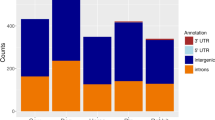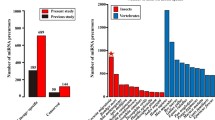Abstract
MicroRNAs (miRNAs) are a class of ∼22 nt long endogenous non-coding RNAs that play important regulatory roles in diverse organisms. Up to now, little is known about the evolutionary properties of these crucial regulators. Most miRNAs were thought to be phylogenetically conserved, but recently, a number of poorly-conserved miRNAs have been reported and miRNA innovation is shown to be an ongoing process. In this work, through the characterization of an miRNA super family, we studied the evolutionary patterns of miRNAs in vertebrates. Recently generated miRNAs seem to evolve rapidly during a certain period following their emergence. Multiple lineage-specific expansions were observed. Homolgous premiRNAs may produce mature products from the opposite stem arms following tandem duplications, which may have important contribution to miRNA innovation. Our observations of miRNAs’ complicated evolutionary patterns support the notion that these key regulatory molecules may play very active roles in evolution.
Similar content being viewed by others
References
Bartel D P. MicroRNAs: genomics, biogenesis, mechanism, and function. Cell, 2004, 116(2): 281–297, 14744438, 10.1016/S0092-8674(04)00045-5, 1:CAS:528:DC%2BD2cXhtVals7o%3D
Lee R C, Feinbaum R L, Ambros V. The C. elegans heterochronic gene lin-4 encodes small RNAs with antisense complementarity to lin-14. Cell, 1993, 75(5): 843–854, 8252621, 10.1016/0092-8674(93)90529-Y, 1:CAS:528:DyaK2cXpslGqtA%3D%3D
Griffiths-Jones S, Grocock R J, van Dongen S, et al. MiRBase: microRNA sequences, targets and gene nomenclature. Nucleic Acids Res 2006, 34(Database issue): D140–D144, 16381832, 10.1093/nar/gkj112, 1:CAS:528:DC%2BD28XisFyhtw%3D%3D
Ambros V. The functions of animal microRNAs. Nature, 2004, 431(7006): 350–355, 15372042, 10.1038/nature02871, 1:CAS:528:DC%2BD2cXnsFaiu7g%3D
He L, Hannon G J. MicroRNAs: small RNAs with a big role in gene regulation. Nat Rev Genet 2004, 5(7): 522–531, 15211354, 10.1038/nrg1379, 1:CAS:528:DC%2BD2cXltVSmsbw%3D
Brennecke J, Stark A, Russell R B, et al. Principles of microRNA-target recognition. PLoS Biol, 2005, 3(3): e85, 15723116, 10.1371/journal.pbio.0030085
Lewis B P, Burge C B, Bartel D P. Conserved seed pairing, often flanked by adenosines, indicates that thousands of human genes are microRNA targets. Cell, 2005, 120(1): 15–20, 15652477, 10.1016/j.cell.2004.12.035, 1:CAS:528:DC%2BD2MXot1ChsA%3D%3D
Pang K C, Frith M C, Mattick J S. Rapid evolution of noncoding RNAs: Lack of conservation does not mean lack of function. Trends Genet, 2006, 22(1): 1–5, 16290135, 10.1016/j.tig.2005.10.003, 1:CAS:528:DC%2BD28Xkt1Wh
Hertel J, Lindemeyer M, Missal K, et al. The expansion of the metazoan microRNA repertoire. BMC Genomics, 2006, 7: 25, 16480513, 10.1186/1471-2164-7-25
Sempere L F, Cole C N, McPeek M A, et al. The phylogenetic distribution of metazoan microRNAs: insights into evolutionary complexity and constraint. J Exp Zoolog B Mol Dev Evol, 2006, 306(6): 575–588, 16838302, 10.1002/jez.b.21118
Tanzer A, Stadler P F. Molecular evolution of a microRNA cluster. J Mol Biol, 2004, 339(2): 327–335, 15136036, 10.1016/j.jmb.2004.03.065, 1:CAS:528:DC%2BD2cXjsl2ns78%3D
Tanzer A, Amemiya C T, Kim C B, et al. Evolution of microRNAs located within Hox gene clusters. J Exp Zoolog B Mol Dev Evol, 2005, 304(1): 75–85, 15643628, 10.1002/jez.b.21021
Maher C, Stein L, Ware D. Evolution of Arabidopsis microRNA families through duplication events. Genome Res, 2006, 16(4): 510–519, 16520461, 10.1101/gr.4680506, 1:CAS:528:DC%2BD28Xjs12ju78%3D
Giraldez A J, Cinalli R M, Glasner M E, et al. MicroRNAs regulate brain morphogenesis in zebrafish. Science, 2005, 308(5723): 833–838, 15774722, 10.1126/science.1109020, 1:CAS:528:DC%2BD2MXjvVantrY%3D
Wang X, Zhang J, Li F, et al. MicroRNA identification based on sequence and structure alignment. Bioinformatics, 2005, 21(18): 3610–3614, 15994192, 10.1093/bioinformatics/bti562, 1:CAS:528:DC%2BD2MXpvFGqsbw%3D
Berezikov E, Cuppen E, Plasterk R H. Approaches to microRNA discovery. Nat Genet, 2006, 38Suppl: S2–S7, 16736019, 10.1038/ng1794, 1:CAS:528:DC%2BD28XltVOmt7c%3D
Thompson J D, Higgins D G, Gibson T J. CLUSTAL W: improving the sensitivity of progressive multiple sequence alignment through sequence weighting, position-specific gap penalties and weight matrix choice. Nucleic Acids Res, 1994, 22(22): 4673–4680, 7984417, 10.1093/nar/22.22.4673, 1:CAS:528:DyaK2MXitlSgu74%3D
Suh M R, Lee Y, Kim J Y, et al. Human embryonic stem cells express a unique set of microRNAs. Dev Biol, 2004, 270(2): 488–498, 15183728, 10.1016/j.ydbio.2004.02.019, 1:CAS:528:DC%2BD2cXkslWmur4%3D
Cohen S M, Brennecke J. Developmental biology. Mixed messages in early development. Science, 2006, 312(5770): 65–66, 16601183, 10.1126/science.1126400, 1:CAS:528:DC%2BD28Xjtlalurk%3D
He L, Thomson J M, Hemann M T, et al. A microRNA polycistron as a potential human oncogene. Nature, 2005, 435(7043): 828–833, 15944707, 10.1038/nature03552, 1:CAS:528:DC%2BD2MXkvVGgs70%3D
O’Donnell K A, Wentzel E A, Zeller K I, et al. c-Myc-regulated microRNAs modulate E2F1 expression. Nature, 2005, 435(7043): 839–843, 15944709, 10.1038/nature03677, 1:CAS:528:DC%2BD2MXkvVGgsLg%3D
Voorhoeve P M, le Sage C, Schrier M, et al. A genetic screen implicates miRNA-372 and miRNA-373 as oncogenes in testicular germ cell tumors. Cell, 2006, 124(6): 1169–1181, 16564011, 10.1016/j.cell.2006.02.037, 1:CAS:528:DC%2BD28Xjt1Khsrg%3D
Krek A, Grun D, Poy M N, et al. Combinatorial microRNA target predictions. Nat Genet, 2005, 37(5): 495–500, 15806104, 10.1038/ng1536, 1:CAS:528:DC%2BD2MXjsF2ksrw%3D
Houbaviy H B, Murray M F, Sharp P A. Embryonic stem cell-specific MicroRNAs. Develop Cell, 2003, 5(2): 351–358, 10.1016/S1534-5807(03)00227-2, 1:CAS:528:DC%2BD3sXmvVCitLg%3D
Houbaviy H B, Dennis L, Jaenisch R, et al. Characterization of a highly variable eutherian microRNA gene. RNA, 2005, 11(8): 1245–1257, 15987809, 10.1261/rna.2890305, 1:CAS:528:DC%2BD2MXntFCgtLg%3D
Bentwich I, Avniel A, Karov Y, et al. Identification of hundreds of conserved and nonconserved human microRNAs. Nat Genet, 2005, 37(7): 766–770, 15965474, 10.1038/ng1590, 1:CAS:528:DC%2BD2MXlslWhs7c%3D
Watanabe T, Takeda A, Mise K, et al. Stage-specific expression of microRNAs during Xenopus development. FEBS Lett, 2005, 579(2): 318–324, 15642338, 10.1016/j.febslet.2004.11.067, 1:CAS:528:DC%2BD2MXitFersg%3D%3D
Chen P Y, Manninga H, Slanchev K, et al. The developmental miRNA profiles of zebrafish as determined by small RNA cloning. Genes Dev, 2005, 19(11): 1288–1293, 15937218, 10.1101/gad.1310605, 1:CAS:528:DC%2BD2MXlt1ynu7c%3D
Giraldez A J, Mishima Y, Rihel J, et al. Zebrafish MiR-430 promotes deadenylation and clearance of maternal mRNAs. Science, 2006, 312(5770): 75–79, 16484454, 10.1126/science.1122689, 1:CAS:528:DC%2BD28XjtFalsbo%3D
Levine M, Tjian R. Transcription regulation and animal diversity. Nature, 2003, 424(6945): 147–151, 12853946, 10.1038/nature01763, 1:CAS:528:DC%2BD3sXlt1CktLw%3D
Elango N, Thomas J W, Yi S V. Variable molecular clocks in hominoids. Proc Natl Acad Sci USA, 2006, 103(5): 1370–1375, 16432233, 10.1073/pnas.0510716103, 1:CAS:528:DC%2BD28Xhs1Ggu7Y%3D
Lai E C, Wiel C, Rubin G M. Complementary miRNA pairs suggest a regulatory role for miRNA: miRNA duplexes. RNA, 2004, 10(2): 171–175, 14730015, 10.1261/rna.5191904, 1:CAS:528:DC%2BD2cXpsVSisA%3D%3D
Khvorova A, Reynolds A, Jayasena S D. Functional siRNAs and miRNAs exhibit strand bias. Cell, 2003, 115(2): 209–216, 14567918, 10.1016/S0092-8674(03)00801-8, 1:CAS:528:DC%2BD3sXosFCqsLs%3D
Schwarz D S, Hutvagner G, Du T, et al. Asymmetry in the assembly of the RNAi enzyme complex. Cell, 2003, 115(2): 199–208, 14567917, 10.1016/S0092-8674(03)00759-1, 1:CAS:528:DC%2BD3sXosFCqsLo%3D
Kim V N. MicroRNA biogenesis: Coordinated cropping and dicing. Nat Rev Mol Cell Biol, 2005, 6(5): 376–385, 15852042, 10.1038/nrm1644, 1:CAS:528:DC%2BD2MXjvF2jsLg%3D
Berezikov E, Thuemmler F, van Laake L W, et al. Diversity of microRNAs in human and chimpanzee brain. Nat Genet, 2006, 38(12): 1375–1377, 17072315, 10.1038/ng1914, 1:CAS:528:DC%2BD28Xht1CntrbE
Farh K K, Grimson A, Jan C, et al. The widespread impact of mammalian MicroRNAs on mRNA repression and evolution. Science, 2005, 310(5755): 1817–1821, 16308420, 10.1126/science.1121158, 1:CAS:528:DC%2BD2MXhtlSntbzL
Author information
Authors and Affiliations
Corresponding author
Additional information
Supported by the National Natural Science Foundation of China (Grant Nos. 30625012, 60572086 and 60775002), and National Basic Research Program of China (Grant No. 2004CB518605)
Rights and permissions
About this article
Cite this article
Wang, X., Zhang, X. & Li, Y. Complicated evolutionary patterns of microRNAs in vertebrates. SCI CHINA SER C 51, 552–559 (2008). https://doi.org/10.1007/s11427-008-0075-z
Received:
Accepted:
Published:
Issue Date:
DOI: https://doi.org/10.1007/s11427-008-0075-z




